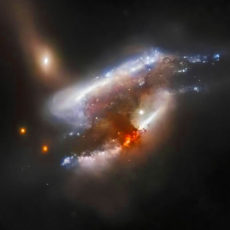
NASA / ESA’s Hubble Space Telescope captures a not so vibrant image of a ghostly supernova, named SN 2024PI, within spiral galaxy LEDA 22057, located 650 million light-years from Earth in the constellation Gemini. You can clearly see it just down and to the right of the galactic nucleus.

It’s classified as a Type Ia supernova, which requires an object called a white dwarf. Why? When a massive star like this one uses up the supply of hydrogen in its core, it balloons into a red giant, becoming cool, puffy and luminous. Over eons, pulsations as well as stellar winds cause the star to shed its outer layers, leaving behind a white dwarf and a planetary nebula. Since white dwarfs are extremely dense, they can pack roughly the mass of the Sun into a sphere the size of Earth.
- BRIGHT, SHARP VIEWS ANYWHERE: Unlike many beginner telescopes, this quality refractor features fully coated glass lenses and a 70mm aperture for...
- PERFECT FIRST TELESCOPE FOR BEGINNERS: Designed for adults and kids to enjoy together, this beginner-friendly telescope sets up in minutes and...
- EASY NO-TOOL SETUP: No complicated assembly or tools needed. The full-height tripod and telescope tube set up in seconds and pack neatly into the...
A spiral galaxy with two thin, slowly-curving arms, one fainter than the other, coming off the tips of a bright, oval-shaped core region. The disc of the galaxy is also oval-shaped and filled with fuzzy dust under the arms. It has some bright spots where stars are concentrated, especially along the arms. The core has a white glow in the centre and thick bands of gas around it. A supernova is visible as a pale blue dot near the core,” said the ESA.













